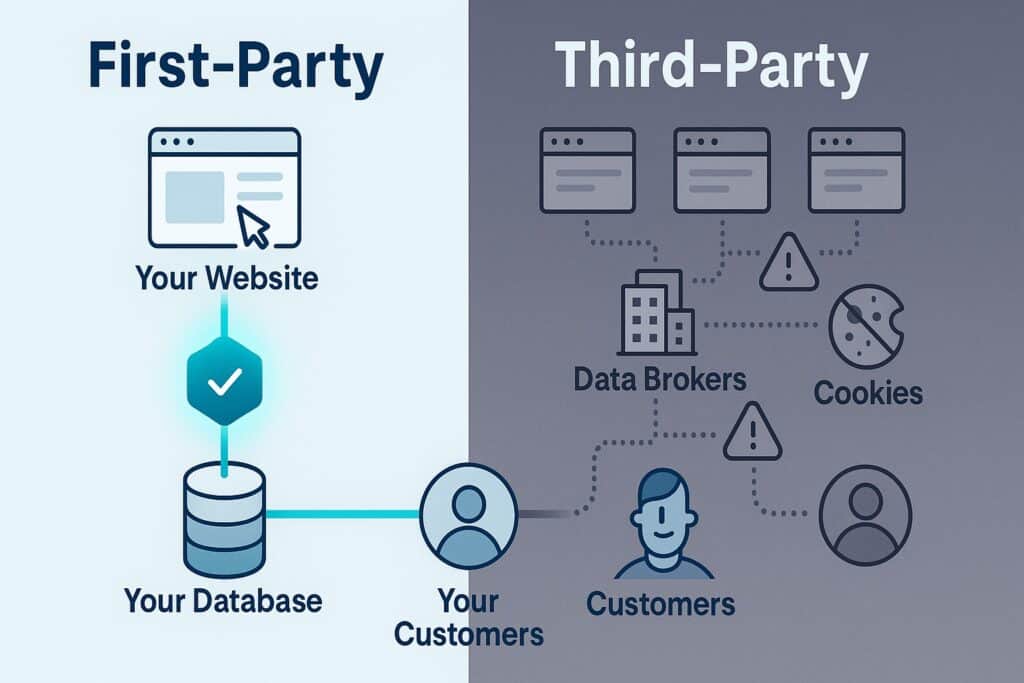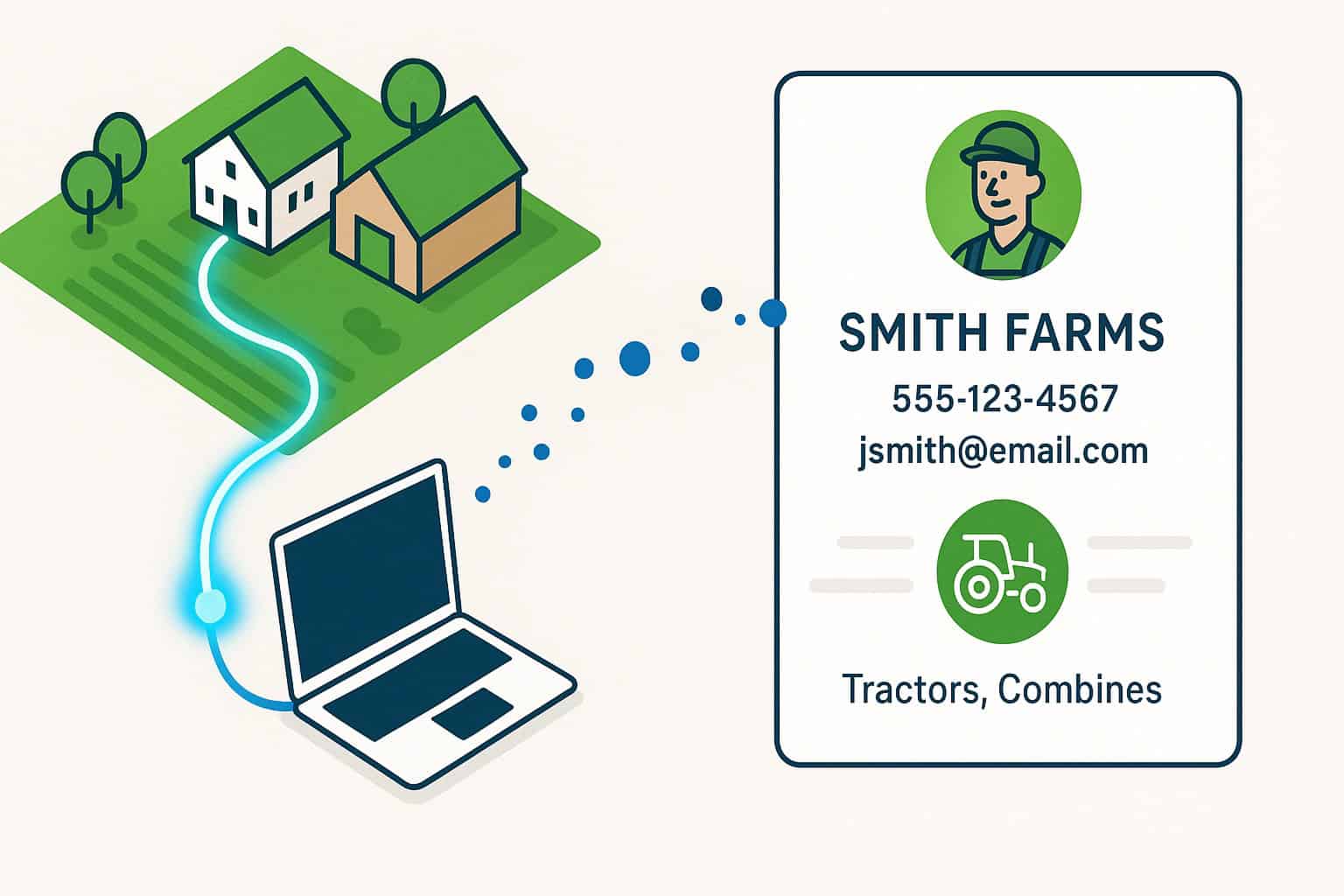In Part 1, we talked about the frustrating reality that 97% of your website visitors leave without identifying themselves. Now let’s pull back the curtain on how anonymous visitor identification technology actually works—and why it’s become essential for agricultural equipment dealers who want to compete effectively.
The Technology Behind the Magic
Anonymous website visitor identification is technology that reveals who’s visiting your website, even when they don’t voluntarily provide their contact information. Think of it as a bridge between the anonymous traffic you see in your analytics and the actual people behind those sessions.
The technology works through several sophisticated methods working together. Let me break down each component in practical terms:
IP Address Analysis: Your First Clue
When someone visits your website from a business or residential location, their IP address contains valuable clues about their identity. For agricultural equipment dealers, this is particularly valuable because many farmers and farm managers browse from known agricultural businesses or their home operations.
The system matches these IP addresses against comprehensive databases to identify potential leads. It’s not magic—it’s data matching. If someone visits from an IP address registered to Smith Family Farms, the system can connect that visit to actual contact information for that operation.
Behavioral Tracking Patterns: The Digital Fingerprint
The system doesn’t just look at a single visit—it tracks patterns across multiple sessions. If someone visits your site three times in a week, spending significant time on your used tractor inventory each time, that behavioral pattern indicates serious buying intent.
Modern visitor identification platforms create unique fingerprints based on browsing behavior, device characteristics, screen resolution, browser type, operating system, and engagement patterns. When combined, these elements create a profile specific enough to recognize returning visitors even without cookies.
Data Enrichment: Connecting the Dots
Once the system identifies a potential match, it enriches that data by cross-referencing multiple databases. This might include business registries, agricultural databases, property records, and consumer information sources.
The result is a detailed profile that includes name, contact information, location, and often additional insights like farm size, crop focus, or equipment preferences. For a commercial operation, you might learn the business name, decision-makers’ names, phone numbers, physical address, and even revenue estimates.
First-Party Data: The Game-Changing Difference
Here’s where things get really interesting. What makes modern visitor identification different from old tracking methods is its focus on first-party data—information you collect and own directly through your website interactions.

What Makes First-Party Data Different?
First-party data is information you collect directly from your audience through their interactions with your brand. It’s fundamentally different from buying lists or relying on third-party tracking cookies that follow people across the internet.
When someone visits your website, they’re interacting with your property. The data collected from that interaction belongs to you. You’re not tracking them across multiple unrelated websites—you’re simply understanding how they engage with your digital presence.
Brands using first-party data see 2.9 times higher revenue and 1.5 times greater cost savings compared to those relying on other data sources. That’s not marketing fluff—those are real dollars impacting your bottom line.
The Step-by-Step Process
Let’s break down what actually happens when you implement anonymous visitor identification—like Fastline Marketing Group’s AGGI solution—on your website:

Step 1: The Invisible Pixel
A small piece of code (called a pixel) gets installed on your website. This is similar to how Google Analytics works, but it’s designed specifically for visitor identification rather than just traffic analysis. The pixel is invisible to visitors and doesn’t slow down your site, but it starts collecting behavioral data immediately.
Step 2: Real-Time Data Collection
As visitors browse your site, the pixel captures their journey: which pages they visit, how long they stay, what they click on, and which products or services they examine. It’s also collecting technical information like IP address, device type, browser characteristics, and engagement patterns. All of this happens in real-time without interrupting the user experience.
Step 3: Identity Resolution
This is where the system earns its keep. It takes all those behavioral signals and technical identifiers and runs them through sophisticated matching algorithms. It’s checking against multiple databases to find matches—business registries for commercial operations, property records for farm locations, and consumer databases for individual buyers.
For agricultural equipment dealers, this often means identifying specific farms, ranches, or agricultural businesses. The system might determine that a visitor is browsing from Smith Family Farms in Nebraska, operating a 2,000-acre corn and soybean operation, and currently in the market for harvesting equipment based on their browsing behavior.
Step 4: Profile Building
Once a match is made, the system enriches that profile with additional information. This might include contact details like email addresses, mailing addresses, along with farm characteristics, equipment ownership history, and buying signals.
The profile becomes increasingly detailed as the same visitor returns multiple times, building a comprehensive picture of their interests and needs. Someone who returns five times over two weeks, spending progressively more time on specific equipment categories, is clearly serious about making a purchase.
Step 5: Actionable Delivery
The identified visitors and their enriched profiles flow directly into your marketing systems. You might receive real-time alerts when high-value prospects visit your site, or have these profiles automatically added to your CRM for follow-up. The data integrates with your email marketing campaigns, direct mail efforts, and re-targeting ad campaigns.
What You Actually Learn
The output of visitor identification is remarkably detailed. For a commercial farm operation visiting your site, you might learn:
- Business name and physical location
- Primary contacts with names and titles
- Direct email addresses
- Farm size and crop focus
- Which specific equipment they viewed
- How many times they’ve visited
- How long they spent on different pages
- What content they downloaded
- Whether they visited from mobile or desktop
- Time of day they typically browse
This intelligence transforms how you market and sell. Instead of generic outreach, you can have informed conversations with people who’ve already demonstrated interest in exactly what you offer.
Privacy and Ethics: Doing It Right
What’s crucial to understand is that this entire process respects privacy boundaries. Legitimate visitor identification systems only reveal information that individuals have made publicly available or have consented to share.
They don’t spy on people or reveal private information—they simply connect the dots between public data sources and website behavior. You’re not hacking into anyone’s computer or accessing confidential information. You’re matching observable website behavior with publicly available business and property records.
Modern systems also include proper consent mechanisms and respect user privacy preferences, keeping you compliant with evolving regulations while still gathering valuable marketing intelligence.
Why This Works Better Than Old Methods
Remember those third-party cookies that marketers used to rely on? They’re mostly gone now. Browsers have blocked them, and privacy regulations have restricted them. Even when they worked, they only provided limited insight and required you to depend on outside platforms.
First-party visitor identification is different. You own the data. You control how it’s collected and used. It works regardless of browser privacy settings (within legal parameters). And because you’re tracking behavior on your own property, it’s more privacy-compliant and future-proof than third-party methods ever were.
What’s Next
Now that you understand how the technology works, the next question is: what do you actually do with all this information? In Part 3, we’ll explore the specific, practical applications for agricultural equipment dealers—from targeted email campaigns to sales team intelligence to event marketing that actually fills seats with qualified buyers.
The technology is impressive, but the real value comes from how you use it.


